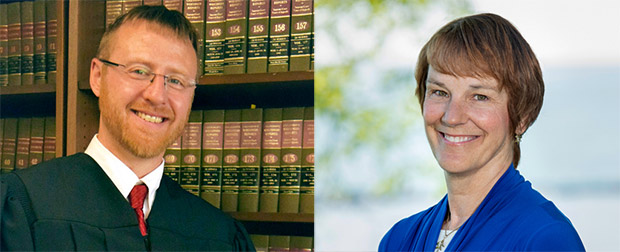Supreme Court rules on equal placement
By: dmc-admin//June 21, 2006//
 |
| Gregg Herman |
A recent high court opinion finally put to rest the debate about equal placement for the children of divorce in Wisconsin.
Specifically, on June 11, 2006, the Wisconsin Supreme Court issued its opinion in Landwehr v. Landwehr, 2006 WI 64 (Jun. 6, 2006), affirming an unpublished opinion of the District I Court of Appeals.
The case resolved the perceived tension between the maximizing placement language set forth in Wis. Stat. § 767.24(4)(a)2 and the status quo presumption in modification actions set forth in Wis. Stat. § 767.325(1)(b)2. In its decision, the justices emphatically rejected the argument that the maximizing placement language set forth in Wis. Stat. § 767.24(4)(a)2 mandates equal placement.
The argument over equal placement has its genesis in the father’s rights movement (a.k.a. the “Mad Dads”) who attempted to convince the Legislature to mandate equal placement with the infamous proposal known as SB 107. In an effort to combat the absurdity of treating children akin to bank accounts, the Family Law Section of the State Bar proposed a compromise, which neutralized SB 107 like a polio vaccine — using an inert version of the virus to defuse the harmful version.
The result was a statute which requires a court to “maximize placement time with both parents,” a mathematical absurdity since, as the Court of Appeals pointed out, allocating placement between parents is a zero-sum game. Two Court of Appeals cases have held that this statute does not mandate equal placement. See Lofthus v. Lofthus, 2004 WI App 65, 270 Wis. 2d 515, 678 N.W.2d 393; Keller v. Keller, 2002 WI App 161, 256 Wis. 2d 401, 647 N. W. 2d 426.
While these Court of Appeals cases appeared to resolve the legislative intent was not to mandate equal placement, the “maximizing placement” language appears to contradict the standard for modifying placement after the divorce. After the initial order, if a child is placed with each parent for substantially equal amounts of time, there is a rebuttable presumption that maintaining substantially equal periods of physical placement is in the best interest of the child. Wis. Stat. § 767.325 (2)(b).
Where the original order places a child with one parent for a greater period of time as compared to the other parent, there exists a rebuttable presumption that continuing the child’s physical placement with the parent with whom the child resides for the greater period of time is in the best interest of the child. Wis. Stat. § 767.325(1)(b)2.b.
As opined in this column prior to the decision, it is highly unlikely that the Legislature ever considered the apparent contradiction. However, it was suggested that, given the importance of maintaining stability for children, the postjudgment presumptions should control, as the best interests of the child should always be paramount.
“Supreme Court Takes Up Placement Issue In Landwehr Case,” Wisconsin Law Journal, Feb. 8, 2006.
While not strictly following this analysis, the high court reached the same conclusion. The court noted that the postjudgment statute: “specifically establishes a presumption of the status quo and specifically requires the court to examine the 16 factors enumerated in Wis. Stat. § 767.24(5). As a result, the circuit court is required to set a placement schedule that establishes meaningful periods of physical placement and maximizes each parent’s time with the child, in the context of the status quo presumption and the 16 factors enumerated in Wis. Stat. § 767.24(5) as applied to the particular facts and circumstances of the child.”
Importantly, the court specifically held that: “[T]he term ‘maximize’ does not supersede the trial court’s discretion to construct a schedule it determines is in the best interest of the child and otherwise in conformity with the intricate dictates of § 767.24.”
The Supreme Court went on to read into the legislation intent to always keep the best interests of the child paramount. Actually, the legislation was, as discussed above, a political compromise intended to defuse a potential disaster for children. No consideration was given to the effect in postjudgment cases or the apparent contradiction.
Still, when it comes to Supreme Court decisions, all is well that ends well. Each placement case needs to turn on its own merits since facts vary from one case to another. Using a cookie-cutter approach to children would inevitably have the effect of creating harm in certain situations where the formula would fit the individual needs of those particular children. As a result, trial courts need to have wide discretion to do what is right for children in each individual case. Sixteen factors, including a catchall of “[S]uch other factors as the court may in each individual case determine to be relevant” (which leads to question why the first fifteen factors are even necessary) allows the trial court to avoid being handcuffed by formulas or by political considerations.
Simply put, children are too important to allow politicians to determine their fate.
Gregg Herman is a shareholder with Loeb & Herman S.C. in Milwaukee. He can be reached at www.loebherman.com or sending an e-mail to [email protected].
Legal News
- Former law enforcement praise state’s response brief in Steven Avery case
- Eric Toney announces re-election bid for Fond du Lac County District Attorney
- Former Wisconsin Democratic Rep. Peter Barca announces new bid for Congress
- Republicans file lawsuit challenging Evers’s partial vetoes to literacy bill
- More human remains believed those of missing woman wash up on Milwaukee Co. beach
- Vice President Harris returning to Wisconsin for third visit this year
- Wisconsin joins Feds, dozens of states to hold airlines accountable for bad behavior
- Trump ahead of Biden in new Marquette poll
- Bankruptcy court approves Milwaukee Marriott Downtown ‘business as usual’ motion
- New Crime Gun Intelligence Center to launch in Chicago
- Arrest warrant proposed for Minocqua Brewing owner who filed Lawsuit against Town of Minocqua
- Wisconsin Supreme Court justices question how much power Legislature should have
WLJ People
- Power 30 Personal Injury Attorneys – Russell Nicolet
- Power 30 Personal Injury Attorneys – Benjamin Nicolet
- Power 30 Personal Injury Attorneys – Dustin T. Woehl
- Power 30 Personal Injury Attorneys – Katherine Metzger
- Power 30 Personal Injury Attorneys – Joseph Ryan
- Power 30 Personal Injury Attorneys – James M. Ryan
- Power 30 Personal Injury Attorneys – Dana Wachs
- Power 30 Personal Injury Attorneys – Mark L. Thomsen
- Power 30 Personal Injury Attorneys – Matthew Lein
- Power 30 Personal Injury Attorneys – Jeffrey A. Pitman
- Power 30 Personal Injury Attorneys – William Pemberton
- Power 30 Personal Injury Attorneys – Howard S. Sicula









